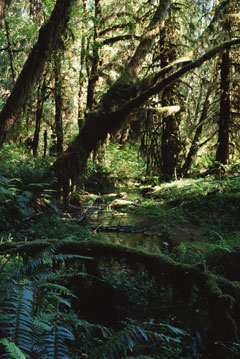
|
|
Temperate rainforests contain much of the planet's biological riches.
|
Properly regulated, the potential economic value of Earth's genetic resources could fuel viable, market-driven incentives to conserve biodiversity, according to Columbia Earth Institute and Business School economist Arthur Small.
In a paper published in the February issue of the Journal of Political Economy, Small and co-author Gordon Rausser of the University of California at Berkeley present a mathematical model demonstrating that a market for conservation is economically plausible. Particularly as the biomedical industry recognizes that potential financial returns from new drugs discovered in nature exceed of the cost of preserving the ecosystems that supply them.
"We're not saying that bioprospecting holds the key to saving all endangered species," Small said. "This is by no means a 'fix-all' conservation mechanism. However, it is credible to think of using the economics of bioprospecting as one useful tool in the effort to preserve Earth's biodiversity."
Bioprospecting involves the search for and exploitation of valuable chemical compounds and genetic material found in wild organisms. The effort is as old as modern science and has yielded many products useful in agriculture, materials science and, notably, pharmaceuticals, where new discoveries can lead to enormous profits.
Virtually all modern medicines are derived from or modeled on chemical compounds found in nature. For example, the antibiotic penicillin is derived from a type of mold; the cancer drug taxol comes from the bark of the Pacific and Himalayan yew tree; and any number of medications are derived from the venom of snakes, spiders and frogs. And now the growing science of genetic manipulation is creating a whole new class of potential discoveries with untold societal and financial value.
"The impetus for their work really grew out of the 1992 Rio de Janeiro Earth Summit Convention on Biological Diversity, which many hoped would create a market-based incentive for preserving biodiversity, particularly for poorer nations that now sacrifice their ecological resources for short-term economic gain, Small said."
The rampant conversion of irreplaceable rain forest to cropland that loses its productivity after only a few years is one obvious example of this unsustainable economic practice.
"The idea was that these countries could lease bioprospecting rights to research and development companies, thus both creating income and preserving their assets," Small said. "But aside from a few notable instances, this has yet to happen."
A 1996 paper in the Journal of Political Economy presented one of the first economic models of the situation in the wake of the Diversity Convention. It concluded that the potential value of any given increment of genetic resources was unlikely to be large enough to create a significant financial conservation incentive. The reasoning behind this conclusion was that, given the enormous number of species on earth, the probable potential value of any one is insignificant.
But Small and Rausser noted a flaw in that model's simplification of the bioprospecting process. It assumed an equally tiny possibility of a valuable find from all biological sources, and characterized the search process itself as one of "brute-force testing unaided by any organizing scientific framework" -- in other words, random luck.
"That simply isn't the way the process works," Small said. "Luck plays a role, but generally only after existing knowledge is applied to narrowing the universe of potential leads to a manageable and promising subset."
For example, plants are known to be generally more chemically creative than animals, presumably because fleeing is not a defensive option. And these chemical defenses tend to be especially well developed in ecosystems where competitive and environmental stresses are particularly acute -- deserts, rain forests, coral reefs and isolated alpine environments.
Building on the foundation laid by the earlier paper, Small and Rausser revamped the model to include a more realistic description of bioprospecting that includes the ability to partition collections of potential research leads into categories of greater and lesser potential. This changed the outcome, suggesting that companies would be willing to pay a premium for exclusive access to promising research prospects, thus creating an incentive to preserve ecological resources in order to charge access fees.
The situation is analogous to the oil industry, where companies pay substantial amounts to purchase the right to drill in areas of known reserves, or where geological analysis suggests that the probability of striking oil is high. Making this work for biodiversity conservation, however, will require a great deal more rigorous research and, eventually, the implementation of a specialized regulatory framework to govern it.
"The concept of a viable conservation market driven by bioprospecting is premised on the protection of property rights to specific biological resources and the products derived from them," Small said. "This presupposes the creation of a legal system along the lines of patent law and the regulations governing intellectual property in the high tech industry."
Small acknowledges that this approach to conservation can only help to protect those species and ecosystems with recognized, exploitable economic value, but sees that as a worthwhile beginning.
"The argument can reasonably be made that there is no telling what valuable use science may discover for a given organism in the future, and so it's wise to maintain the largest toolkit of biodiversity possible. I agree with that intuitively," Small said. "The trick is in pinning down the economics of it."
Of course there are many other benefits associated with environmental conservation that can be quantified, such as the filtering role of pristine ecosystems in providing clean air and water, as well as benefits that defy numbers, like the aesthetic and spiritual value of nature.
"Our work is really just part of a larger effort to capture these kinds of values in economic terms," Small said, "in order to provide tangible, measurable incentives for conservation."
|
